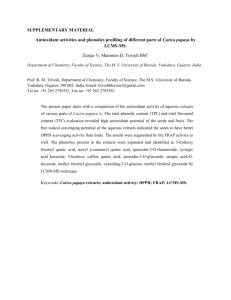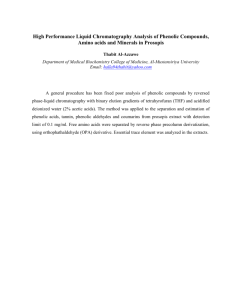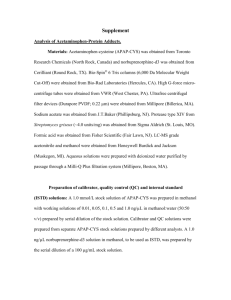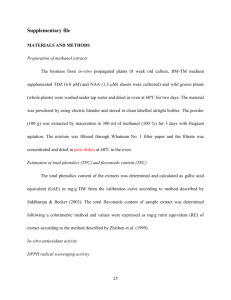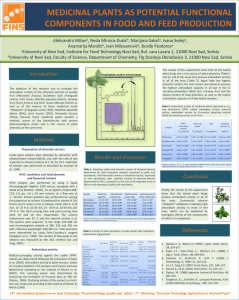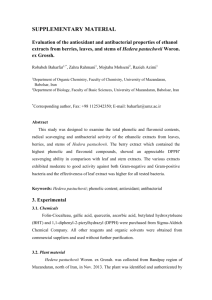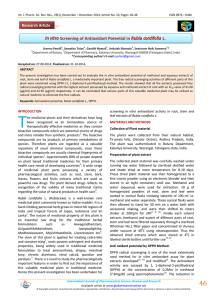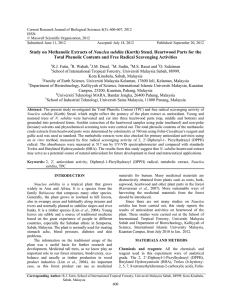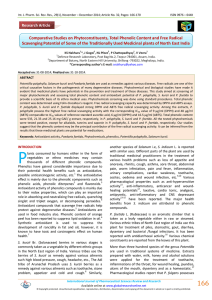References
advertisement
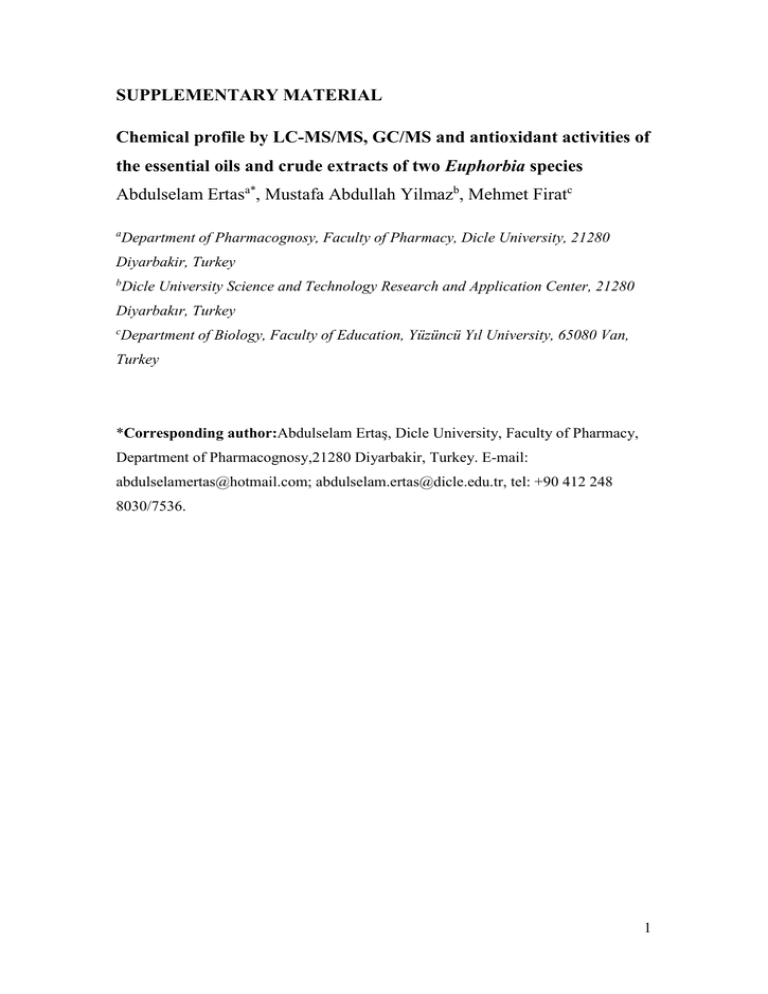
SUPPLEMENTARY MATERIAL Chemical profile by LC-MS/MS, GC/MS and antioxidant activities of the essential oils and crude extracts of two Euphorbia species Abdulselam Ertasa*, Mustafa Abdullah Yilmazb, Mehmet Firatc a Department of Pharmacognosy, Faculty of Pharmacy, Dicle University, 21280 Diyarbakir, Turkey b Dicle University Science and Technology Research and Application Center, 21280 Diyarbakır, Turkey c Department of Biology, Faculty of Education, Yüzüncü Yıl University, 65080 Van, Turkey *Corresponding author:Abdulselam Ertaş, Dicle University, Faculty of Pharmacy, Department of Pharmacognosy,21280 Diyarbakir, Turkey. E-mail: abdulselamertas@hotmail.com; abdulselam.ertas@dicle.edu.tr, tel: +90 412 248 8030/7536. 1 Abstract In the current study, it was aimed to investigate the chemical composition and antioxidant activities of two Euphorbia species. The major component of the fatty acid compositions obtained from the petroleum ether extracts was identified as palmitic acid for Euphorbia gaillardotii and E. macroclada. The main constituents of the essential oils were identified as arachidic acid for E. gaillardotii and tetratetracontane for E. macroclada. Among the studied twenty-seven compounds, hesperidin, rutin, hyperoside and quinic, malic, gallic and tannic acids were found to be the most abundant compounds in two Euphorbia species. The methanol extracts of E. gaillardotii and E. macroclada showed strong antioxidant activity in all tested methods. Particularly, IC50 values of E. macroclada methanol extract that was the richest in terms of total phenolic-flavonoid contents, were found to be lower than α-tocopherol and BHT (butylated hydroxytoluene) in β-carotene bleaching, DPPH (2,2-diphenyl1-picrylhydrazyl) free and ABTS cation radical scavenging methods. Keywords: Euphorbia gaillardotii; Euphorbia macroclada; LC-MS/MS; GC/MS; antioxidant activity. 2 Experimental Chemicals and instruments Phenolic, essential oil and fatty acid compositions of Euphorbia species were determined by using Shimadzu UHPLC ESI MS/MS (Shimadzu, Kyoto, Japan), and GC/MS instruments, respectively. A Shimadzu UV spectrophotometer and BioTek Power Wave XS microplate reader (USA) were used for the activity assays. 2,2′azinobis(3-ethylbenzothiazoline-6-sulfonic acid) diammonium salt (ABTS) (purity: 97.5%), and butylated hydroxytoluene (BHT) (≥99%) were purchased from Merck (Germany); quercetin (%95), protocatechuic acid (%97), chrysin (%97), rutin (%94), hesperatin (%95), naringenin (%95), rosmarinic acid (%96), vanillin (%99), pcoumaric acid (%98), caffeic acid (%98), chlorogenic acid (%95), formic acid (≤ 100%), 2,2-diphenyl-1-picrylhydrazyl (DPPH) (≥ 95%), -carotene, linoleic acid (≥ 93%), Tween 40, pyrocathecol (≥ 99%) and 5,5-dithiobis-(2-nitro benzoic acid) (DTNB) (≥ 98%), were obtained from Sigma (Germany); -tocopherol (≥ 95.5%) was from Aldrich (Germany). Plant material We collected the whole plants of Euphorbia gaillardotii BOISS. ET BLANCHE and Euphorbia macroclada BOISS from southeast of Turkey (Diyarbakır) in July 2013 by Dr. A. Ertaş (Department of Pharmacognosy, Faculty of Pharmacy, Dicle University) and they were identified by Mehmet Fırat (Department of Biology, Faculty of Education, Yüzüncü Yıl University). Voucher specimens have been strored in the Herbarium of Yüzüncü Yıl University(VANF: 30185 for Euphorbia gaillardotii and VANF: 30186for Euphorbia macroclada). Preparation of plant extracts for biological activities and GC/MS Whole plant materials were dried and powdered, 100 g of each plant material were sequentially macerated with petroleum ether and methanol for 24 hour at 25°C. The solvents were evaporated after filtration thus crude extracts were obtained. Essential oils were obtained using a Clevenger apparatus from the aerial parts of plants (100 g), which were crumbled into small pieces and soaked in distilled water (500 ml) for 3 h. 3 Esterification of total fatty acids and GC/MS conditions A hundred milligram of the petroleum ether extract was refluxed in 0.1 M KOH solution in 2 mL of methanol during 1h, the solution was cooled and 5 mL of water was added. The aqueous mixture was neutralized with 0.5 mL of HCl solution, it was extracted with diethyl ether: hexane (1 : 1; 3.5 mL) mixture. The separating organic phase was washed with 10 mL water, and dried over anhydrous Na2SO4. The solvent was evaporated under vacuum and then fatty acid methyl esters were obtained. The analyses were performed using a Thermo Scientific Polaris Q GC-MS/MS. GC/MS procedure described by Kılıc et al. (2007) was applied. Preparation and GC/MS conditions for essential oil Essential oil was obtained using a Clevenger apparatus from the aerial parts of theplant (100 g), which was crumbled into small pieces and soaked in distilled water (500 ml) for 3 h. The obtained essential oil was dried over anhydrous Na2SO4 and stored at +4 C for a sufficient period of time.The essential oil was diluted using CH2Cl2 (1:3 volume/volume) prior to GC/FID (Gas Chromatography/Flame Ionization Detector) and GC/MS analysis. GC/FID analysis was performed using Thermo Electron Trace GC/FID detector and GC/MS analysis was performed using the same GC and Thermo Electron DSQ MS. The following GC conditions were applied for both GC/MS and GC/FID analyses. The GC oven temperature was kept at 60 C for 10 min and programmed to 280 °C at a rate of 4 °C/min and then kept constant at 280 °C for 10 min. A nonpolar Phenomenex DB5 fused silica column (30 m0.32 mm, 0.25 μm film thickness) was used with helium at 1 mL/min (20 psi) as a carrier gas. The split ratio was adjusted to 1:50, the injection volume was 0.1 μL, and EI/MS was recorded at 70 eV ionization energy. The mass range was m/z 35–500 amu. n-Alkanes (C8-C24) and pentacosane, hexacosane, octacosane, tricontane, and tetracontane from Ultrakkit WRK-101 Hydrocarbons # 2 were used as reference points in the calculation of Kovats Indices (KI) by the same conditions(Altun et al. 2007; Ertas et al. 2014). Identification of the compounds was based on comparing their retention times and mass spectra with those obtained from authentic samples and/or the NIST and Wiley spectra as well as data from the published literature. 4 Determination of total phenolic and flavonoid contents The concentrations of phenolic content in the crude extracts were expressed as micrograms of pyrocatechol equivalents (PEs) (Slinkard & Singleton 1977). 100 μL solution of the samples in methanol was added to 4.6 mL of distilled water and 100 μL of Folin-Ciocalteu’s Reagent, and mixed thoroughly. After 3 min, 300 μL sodium carbonate (2%) was added to the mixture and shaken intermittently for 2 h at room temperature. The absorbance was read at 760 nm. The concentration of phenolic compounds was calculated according to the following equation that was obtained from standard pyrocatechol graphic: Absorbance = 0.0164 pyrocatechol (μg) + 0.0266 (R2 = 0.9969) Measurement of flavonoid content of the crude extracts was based on the method described by Moreno et al. with a slight modification and results were expressed as quercetin equivalents (Moreno et al. 2000). An aliquot of 1 mL of the solution (contains 1 mg of crude extract in methanol) was added to test tubes containing 0.1 mL of 10% aluminium nitrate, 0.1 mL of 1 M potassium acetate and 3.8 mL of methanol. After 40 min at room temperature, the absorbance was determined at 415 nm.The concentration of flavonoid compounds was calculated according to the following equation: Absorbance = 0.1519 quercetin (μg) – 0.1294 (R2 = 0.9986) Antioxidant activity of the extracts To establish the antioxidant activity, we used the β-carotene-linoleic acid test system, DPPH free radical and ABTS cation radical scavenging activity methods. -Carotene bleaching method 0.5 mg of -carotene in 1 mL of chloroform was added into linoleic acid (25 L) and Tween 40 emulsifier (200 mg) mixture. After evaporating chloroform, 100 mL of distilled water saturated with oxygen was added followed by shaking, 160 μL of this mixture was transferred into different test tubes containing 40 μL of the sample solutions at different concentrations. The emulsion was added to each tube, the zero time absorbances of the values were read at 470 nm. The mixture was incubated for 2 h at 50 C (Miller 1971). 5 Free radical scavenging activity method 0.1 mM, 160 µL of DPPH solution in methanol was added to 40 µL of sample solutions in methanol at different concentrations. After 30 min. the absorbance values were read at 517 nm. The DPPH free radical scavenging potential was calculated using the following equation: DPPH scavenging effect (Inhibition %) = Acontrol Asample Acontrol 100 AControl is the initial concentration of the DPPH• ASample is the absorbance of the remaining concentration of DPPH• in the presence of the extracts or positive controls (Blois 1958). ABTScation radical decolorization assay Seven milimolar ABTS in H2O was added to 2.45 mM potassium persulfate to produce ABTS•+and solution was stored in the dark at 25 C for 12 h. The prepared solution was diluted with ethanol to get an absorbance of 0.700 ± 0.025 at 734 nm. ABTS•+ solution (160 µL) was added to each sample solution at different concentrations. After 30 min, the percentage inhibition at 734 nm was read for each concentration relative to a blank absorbance (methanol). The following equation was used to calculate the scavenging capability of ABTS•+ (Re et al. 1999; Ertas et al. 2014): ABTS•+ scavenging effect (Inhibition %) = Acontrol Asample Acontrol × 100 Identification and Quantitation of Phenolic Compounds Preparation of plant extracts for LC-MS/MS The air-dried and powdered plant materials (10g) were extracted three times with 100 ml of methanol for 24 hours at room temperature. The solvents were removed from the filtered extract solutions under vacuum at 30 ºC in a rotary evaporator, until dry methanol extracts were obtained. Dry filtrates were diluted to 250 mg/L and fitrated with 0.2 μm microfiber filter prior to LC-MS/MS analysis. Instruments and Chromatographic Conditions LC-MS/MS analysis of the phenolic compounds were performed by using a Nexera model Shimadzu UHPLC coupled to a tandem MS instrument. The liquid chromatograph was equipped with LC-30AD binary pumps, DGU-20A3R degasser, 6 CTO-10ASvp column oven and SIL-30AC autosampler.The chromatographic seperation was performed on a C18 reversed-phase Inertsil ODS-4 (150 mm×4,6 mm, 3µm) analytical column. The column temperature was fixed at 40˚C. The elution gradient consisted of mobile phase A (water, 5mM ammonium formate and 0.1% formic acid) and mobile phase B (methanol, 5mM ammonium formate and 0.1% formic acid). The gradient program with the following proportions of solvent B was applied t (min), %B: (0, 40), (20, 90), (23.99, 90), (24, 40), (29, 40). The solvent flow rate was maintained at 0.5 mL/min and injection volume was settled as 4 µL. MS Instrumentation MS detection was performed using Shimadzu LCMS 8040 model triple quadrupole mass spectrometer equipped with an ESI source operating in both positive and negative ionization modes. LC-MS/MS data were collected and processed by LabSolutions software (Shimadzu, Kyoto, Japan). The multiple reaction monitoring (MRM) mode was used to quantify the analytes: the assay of investigated compounds was performed following two or three transitions per compound, the first one for quantitative purposes and the second and/or the third one for confirmation. Optimization of the LC-MS/MS Method Subsequent to several combinations of trials, a gradient of methanol (5mM ammonium formate and 0.1% formic acid) and water (5mM ammonium formate and 0.1% formic acid) system was concluded to be the best mobile phase solution. For rich ionization and the seperation of the molecules, the mentioned mobile phase was proved to be the best of all. ESI source was chosen instead of APCI (Atmospheric Pressure Chemical Ionization) and APPI (Atmospheric Pressure Photoionization) sources as the phenolic compounds were small and relatively polar molecules. Tandem mass spectrometry was decided to be used for the current study since this system is commonly used for its fragmented ion stability (Ertas et al. 2014). The working conditions were determined as interface temperature; 350 C, DL temperature; 250 C, heat block temperature; 400 C, nebulizing gas flow (Nitrogen); 3L/min and drying gas flow (Nitrogen); 15L/min. Method Validation Parameters for LC-MS/MS In the current study, twenty-four phenolic compounds (flavonoids, flavonoid glycosides, phenolic acids, phenolic aldehyde, coumarin) and three non-phenolic 7 organic acids which are widespread in edible plant materials were qualified and quantified in two Euphorbia species. In the chromatographic analysis of phenolic compounds, gradient seperation was applied. Linear regression equations of the phenolic compound standards wererepresented in Table S3. The linearity of the phenolic standards was affirmed in the following ranges: 0,025-1 mg/L, 0,01-4 mg/L, 0,25-10 mg/L (Table S3). The regression coefficient of each calibration graph was found to be higher than 0.99. The limit of detection (LOD) and limit of quantitation (LOQ) of the method reported in this study were dependent on the calibration curve established from six measurements. LOD and LOQ of the method were determined by using the equations 3S/N and 10S/N respectively (S/N refers to the Signal to noise ratio) (Table S3). Fordifferent compounds, LOD ranged from 0.05to 25.8 µg/L and LOQ ranged from 0.17to 85.9 µg/L (Table S3). Furthermore, the recovery of the phenolic compounds standards ranged from 97% to 106.3%. Statistical analysis The results of the antioxidant activities and total phenolic-flavonoid contents were expressed as means SEM. The results were evaluated using an unpaired t-test and ANOVA variance analysis with the NCSS statistical computer package. The differences were considered statistically significant at p 0.05. 8 A B C Figure S1.LC-MS/MS chromatograms of A: 250 ppb standard mix, B: E. gaillardotiimethanol extract, C: E. macrocladamethnol extract. 1: Quinic acid, 2: Malic acid, 3: tr-Aconitic acid, 4: Gallic acid, 5: Chlorogenic acid, 6: Protocatechuic acid, 7: Tannic acid, 8: tr- caffeic acid, 9: Vanillin, 10: p-Coumaric acid, 11: Rosmarinic acid, 12: Rutin, 13: Hesperidin, 14: Hyperoside, 15: 4-OH Benzoic acid, 16: Salicylic acid, 17: Myricetin, 18: Fisetin,19: Coumarin, 20: Quercetin, 21: Naringenin, 22: Hesperetin, 23: Luteolin, 24: Kaempferol, 25: Apigenin, 26: Rhamnetin, 27: Chrysin. 9 Table S1.GC-MS analysis of the petroleum ether extracts of E. gaillardotii (EGP) and E. macroclada (EMP). Rt (min)a 12.00 14.39 18.60 25.27 30.64 30.77 30.86 31.54 37.38 39.36 43.82 Constituentsb Lauric acid 10-Undecenoic acid Myristic acid Palmitic acid Linoleic acid Oleic acid Linolenic acid Stearic acid Arachidic acid Docosane Behenic acid Composition (%)c EGP EMP 1.7 1.3 0.6 5.8 4.5 32.5 33.3 14.5 26.6 21.3 14.2 14.0 11.0 4.2 4.2 4.5 1.4 1.1 1.3 1.3 Total 99.8 99.5 a Retention time (as minutes). b A nonpolar Phenomenex DB-5 fused silica colum. c Percentage of relative weight. Table S2. Chemical composition of the essential oils fromE. gaillardotii (EGEss) and E. macroclada (EMEss). RIa Constituentsb Composition (%)c 1188 1368 1377 1409 1455 1484 1498 1528 1583 1654 1677 1800 1986 2156 2171 2185 2259 2366 2852 2900 3094 3508 3600 4400 α -Terpineol Mint furanone α-Copaene Caryophyllene α-Humulene Valencene α-Silenene α-Muurolene Caryophyllene oxide Eudesmol Cadalene Octadecane Hexadecanoic acid 1-Nonadecanol Butyl phthalate Z-8-Octadecen-1-ol acetate 2,5-Di-tert octyl-p-benzoquinone Arachidic acid 1-Hexacosanol Nonacosane Ethyl iso-allocholate 17-Pentatriacontene Hexatriacontane Tetratetracontane Total EGEss 0.5 8.4 0.4 0.3 0.3 5.2 0.8 4.0 0.3 5.6 8.0 3.3 3.0 3.2 32.0 3.0 3.1 8.7 6.2 96.3 EMEss 0.7 6.0 0.8 0.5 0.4 7.3 1.5 1.2 0.6 1.4 1.9 1.9 4.0 3.2 2.2 1.9 2.2 2.0 12.0 42.7 93.4 a RI Retention indices (DB-5 column) A nonpolar Phenomenex DB-5 fused silica column c Percentage of relative weight. b 10 Table S3. Analytical parameters of LC- MS/MS method Analyte no 1 2 3 4 5 6 7 8 9 10 11 12 13 14 15 16 17 18 19 20 21 22 23 24 25 26 27 Analytes Quinic acid Malic acid tr-Aconitic acid Gallic acid Chlorogenic acid Protocatechuic acid Tannic acid tr- caffeic acid Vanillin p-Coumaric acid Rosmarinic acid Rutin Hesperidin Hyperoside 4-OH Benzoic acid Salicylic acid Myricetin Fisetin Coumarin Quercetin Naringenin Hesperetin Luteolin Kaempferol Apigenin Rhamnetin Chrysin RT 3.36 3.60 4.13 4.25 5.29 5.51 6.30 7.11 8.57 9.17 9.19 9.67 9.69 9.96 11.38 11.39 11.42 12.10 12.18 13.93 14.15 14.80 14.84 14.85 16.73 18.41 20.60 Equation f(x)=33.6626*x+25132.9 f(x)=93.6102*x-5673.77 f(x)=79.2908*x-28416.2 f(x)=358.069*x+26417.5 f(x)=48.9828*x+26779.7 f(x)=36.8568*x+6197.38 f(x)=90.2704*x+30233.2 f(x)=1585.16*x+83957.5 f(x)=44.5478*x-574.867 f(x)=73.5303*x+27064.3 f(x)=18.0298*x-1149.86 f(x)=51.8835*x+3841.66 f(x)=195.773*x+105641 f(x)=0.978146*x+827.221 f(x)=635.003*x+54284.6 f(x)=915.178*x+72571.4 f(x)=54.2823*x+5414.67 f(x)=331.870*x+34409.0 f(x)=236.639*x+34370.3 f(x)=206.102*x+1693.14 f(x)=1100.55*x+39055.7 f(x)=160.323*x+6545.07 f(x)=111.474*x+3057.10 f(x)=20.9677*x+571.241 f(x)=543.793*x+18525.6 f(x)=110.091*x+632.444 f(x)=698.787*x+23531.7 R2a RSD%b 0.9927 0.9975 0.9933 0.9901 0.9932 0.9991 0.9955 0.9942 0.9995 0.9909 0.9992 0.9971 0.9973 0.9549 0.9925 0.9904 0.9991 0.9988 0.9924 0.9995 0.9956 0.9961 0.9992 0.9917 0.9954 0.9994 0.9965 0.0388 0.1214 0.3908 0.4734 0.1882 0.5958 0.9075 1.0080 0.4094 1.1358 0.5220 0.8146 0.1363 0.2135 1.4013 0.6619 2.8247 2.4262 0.4203 4.3149 2.0200 1.0164 3.9487 0.5885 0.6782 2.5678 1.5530 Linearity Range (mg/L) 250-10000 250-10000 250-10000 25-1000 250-10000 100-4000 100-4000 25-1000 250-10000 100-4000 250-10000 250-10000 250-10000 100-4000 25-1000 25-1000 100-4000 100-4000 100-4000 25-1000 25-1000 25-1000 25-1000 25-1000 25-1000 25-1000 25-1000 LOD/LOQ (µg/L) Recovery (%) 22.3 / 74.5 19.2 / 64.1 15.6 / 51.9 4.8 / 15.9 7.3 / 24.3 25.8 / 85.9 10.2 / 34.2 4.4 / 14.7 10.1 / 33.7 15.2 / 50.8 10.4 / 34.8 17.0 / 56.6 21.6 / 71.9 12.4 / 41.4 3.0 / 10.0 4 / 13.3 9.9 / 32.9 10.7 / 35.6 9.1 / 30.4 2.0 / 6.8 2.6 / 8.8 3.3/ 11.0 5.8 / 19.4 2.0 / 6.6 0.1 / 0.3 0.2 / 0.7 0.05 / 0.17 103.3 101.4 102.8 102.3 99.7 100.2 97.8 98.6 99.2 98.4 101.7 102.2 100.2 98.5 106.2 106.2 106.0 96.9 104.4 98.9 97.0 102.4 105.4 99.1 98.9 100.8 102.2 a RT: Retention time R2: coefficient of determination c RSD: relative standard deviation d LOD/LOQ(µg/L): Limit of deteection/Limit of quantification b References Altun M, Goren AC. 2007. Essential oil composition of Satureja cuneifolia by simultaneous distillation-extraction and thermal desorption GC-MS techniques. J Essent Oil Bear Pl. 10: 139-144. Binici B, Bilsel M, Karakas M, Koyuncu I, Goren AC. 2013. An efficient GC-IDMS method for determination of PBDEs and PBB in plastic materials. Talanta 116: 417-426. Blois M.S.1958. Antioxidant determinations by the use of a stable free radical. Nature 181: 1199-1200. Ertas A, Boga M, Hasimi N, Yesil Y, Goren AC, Gulacti T, Kolak U. 2014. Antioxidant, anticholinesterase, antimicrobial activities and fatty acid constituents of Achillea cappadocica Hausskn. et Bornm. Turk J Chem. 38: 592-599. 11 Ertas A, Boga M, Yılmaz MA, Yesil Y, Hasimi N, Kaya MS, Temel H, Kolak U. 2014.Chemical compositions by using LC-MS/MS and GC-MS and biological activities of Sedum sediforme (Jacq.) Pau. J Agr Food Chem.62(20): 4601– 4609. Ertas A, Goren AC, Boga M, Yesil Y, Kolak U. 2014. Essential oil compositions and anticholinesterase activities of two edible plants Tragopogon latifolius var. angustifolius and Lycopsis orientalis. Nat Prod Res.DOI:10.1080/14786419.2014.905558. EURACHEM CITAC Guide CG4. 2004. Quantifiying Uncertainty in Analytical Measurement. 3th ed. Editors: Ellison SLR, (LGC, UK); Williams, A. (UK). Kılıc T, Dirmenci T, Goren AC. 2007. Chemotaxonomic evaluation of species of Turkish Salvia: fatty acid composition of seed oils. II. Rec Nat Prod. 1: 17-23. Miller HE. 1971. A simplified method for the evaluation of antioxidants. J Am Oil Chem. Soc.48: 91. Moreno MIN, Isla MI, Sampietro AR,Vattuone MA. 2000. Comparison of the free radical-scavenging activity of propolis from several regions of Argentina. J Ethnopharmacol. 71: 109-114. Re R, Pellegrini N, Proteggente A, Pannala A, Yang M,Rice-Evans C. 1999. Antioxidant activity applying an improved ABTS radical cation decolorization assay. Free Radical Bio Med. 26: 1231-1237. Slinkard K, Singleton VL. 1977. Total phenol analyses: Automation and comparison with manual methods. Am J Enol Viticult. 28: 49-55. 12 13
